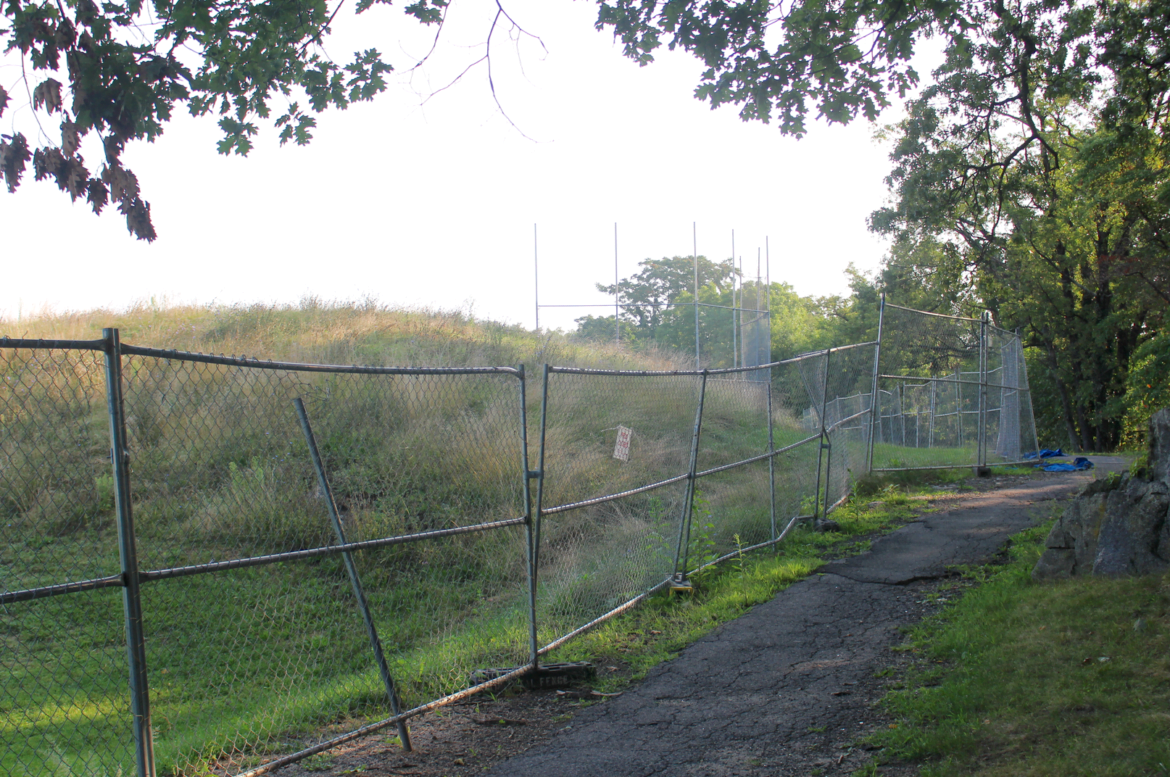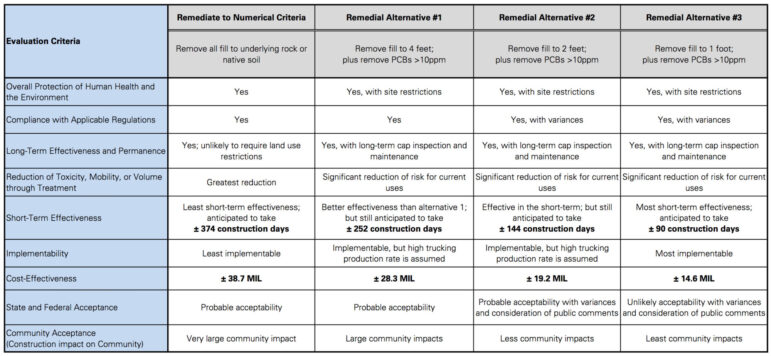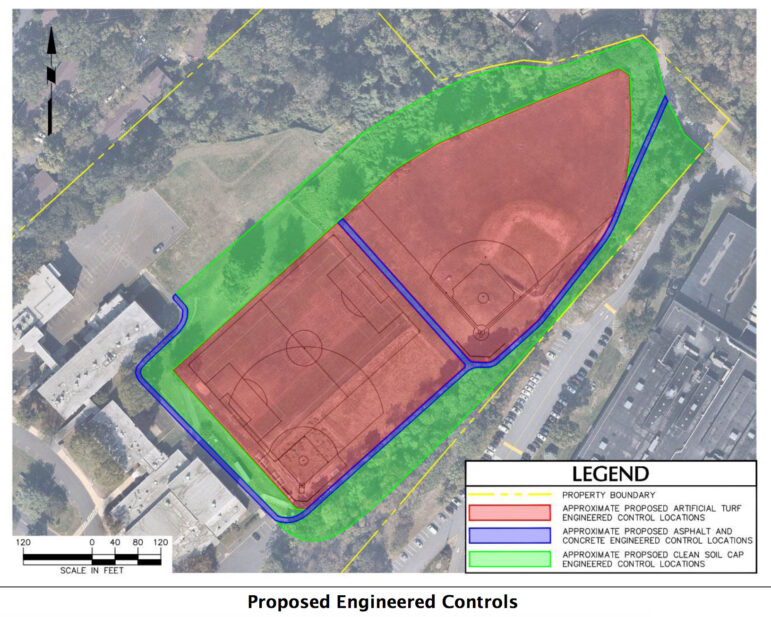Back in 2016 soil samples taken from the fields at Western Middle School revealed contamination. The the fields were closed as a precautionary measure, disrupting school activities including PE and after school sports.
Entire classes of children have graduated without having had use of the school fields.
Over the years over 550 soil samples have been collected across the fields to depths of 10 feet.
In 2020 Greenwich Schools joined the voluntary program for a Remediation Action Plan and has been working with both DEEP and EPA.
A Remedial Action Plan, or “RAP,” was prepared by Langan Engineering and Environmental Services, who are managing the project, and submitted on August 1, 2022.
A copy of the RAP can be viewed here.


According to the RAP fill material imported in the early-1960s is the primary source of contamination. Constituent of concern (COCs) identified in the fill include Volatile organic compound (VOCs), Semi-volatile organic compound (SVOCs,) pesticides, metals, and Polychlorinated biphenyl (PCBs).
According to the RAP, PCBs have been determined to be the main driver for remediation.
Although pesticides have also been identified in surficial soils, pesticide impacts are likely the result of grounds-keeping activities, and likely not inherent to the fill material brought to the subject property.
Investigations have identified two areas of concern: the athletic fields and the recreational area.
Area of Concern: Athletic Fields (AOC-1)
Based on a review of historical aerial photos and topographic maps Langan believes the fill material used in the athletic fields was brought in to raise grades at the athletic fields during the construction of the middle school in the early 1960s. The fill contains varying amounts of deleterious materials including brick, charcoal, glass, ceramic, wood, metal, fibers, organic material, and construction and demolition debris.
Area of Concern: Recreational Area (AOC-2)
In the recreational area, Langan said their review leads them to believe the historic fill is primarily reworked on-site material, placed and graded during construction of the school. This fill was observed to consist of silty sand with gravel, similar to the presumed native soils, but did not contain the same deleterious material identified in the athletic field fill.
Investigations at the recreational area found arsenic at concentrations exceeding the RDEC (Residential Direct Exposure Criteria) and the pesticides 4,4’-DDT and chlordane at concentrations exceeding the GB (geochemical background) PMC (Pollutant Mobility Criteria).
The RAP presents alternative approaches with a range of depths of excavation, range of costs in the tens of millions of dollars and range of the number of days to complete.
All alternatives would impact the community in terms of heavy trucks using local roads daily, with more truck loads depending on how much fill is removed. The more fill removed, the longer the loss of athletic fields use and disruption to regular school functions.
*Langan recommends alternative #2
Under the recommended alternative #2, removing 2 feet of fill, remedial excavation and backfill activities are estimated to take 108 work days. It is estimated that an average of 30 trucks hauling waste and 30 trucks hauling clean backfill would be required each work day to meet the estimated schedule. With a 10-hour work day, this is an average of 6 trucks per hour entering and leaving the site.
Alternatives
• remove all fill to underlying rock or native soil for the greatest reduction of risk for current uses at a cost of ± $38.7 million and ± 374 construction days. This alternative would have a “very large community impact” but in terms of long-term effectiveness and permanence, land use restrictions would be unlikely.
Langan’s RAP says this approach is not feasible given the volume of material to be removed, high cost and number of construction days.
• remove fill to 4 feet for significant reduction of risk for current uses at a cost of ± $28.3 Million and ±252 construction days. This alternative would offer long-term effectiveness and permanence with a cap installed and long-term cap inspection and maintenance.
• *remove fill to 2 feet for significant reduction of risk for current uses with a cost of ± $19.2 Million and 108 to 144 construction days. This alternative would offer long-term effectiveness and permanence with a cap installed and long-term cap inspection and maintenance.
• remove fill to 1 foot for significant reduction of risk for current uses at a cost of ± $14.6 million and ± 90 construction days. This alternative would offer long-term effectiveness and permanence with a cap installed and long-term cap inspection and maintenance. Langan’s RAP says that while this alternative is most implementable, it is unlikely to be acceptable by the state and federal government.



Cleanup activities are expected to start in summer 2023, contingent upon regulatory approval.
The public hearing on January 11 in the Western Middle School auditorium and is open to the entire Greenwich community.
The hearing will begin at 6:00pm and will allow for individual questions with regulators Connecticut DEEP and Connecticut EPA, as well as key AECOM and Langan staff.
At approximately 6:45pm, the public hearing portion will begin with short introductions, an overview, and then followed by public comment and questions taken from the community at a podium. It will be important that the regulators hear from our community. Speakers will sign up to speak at the meeting and follow the order they signed up.
Members of the community are strongly encouraged to attend the public hearing, either in person or virtually.
Also, the Board of Education encourages members of the community to directly email the CT Department of Energy & Environmental Protection (DEEP) your comments regarding the planned action to cap the field and why this project is important to our community.
If this project is important to you, please send an email to voice your thoughts on completing the remediation via the planned action to cap the field and why this project is important to our community.
CT DEEP’s Remediation Project Manager Jeffrey Wilcox is expecting emails at [email protected].
Bookmark and print the updated fact sheet so you can have all of the details at your fingertips.
You can attend the public hearing either in person in the WMS auditorium or virtually.
The meeting can be attended in person or joined remotely using the link below: https://us02web.zoom.us/j/86572888389
Or Dial (312) 626-6799 |
Webinar ID: 86572888389
The public can offer input on the RAP by providing comments to DEEP by January 17, 2023.
Written comments can be submitted to:
Jeffrey Wilcox, CT DEEP79 Elm Street, Hartford, CT 06106
[email protected]
More information:
https://portal.ct.gov/DEEP/Remediation–Site-Clean-Up/Remediation-Site-Clean-Up
DEEP List of contaminated sites in Greenwich, pages 12-43
